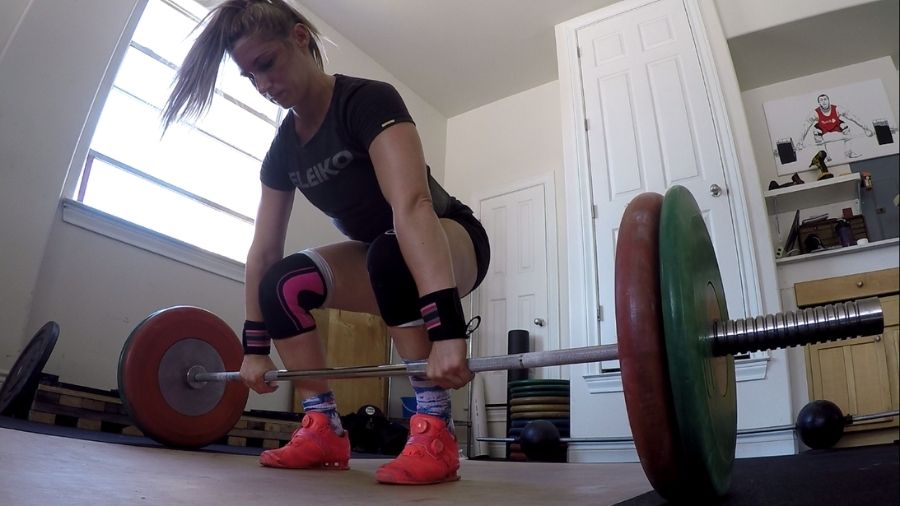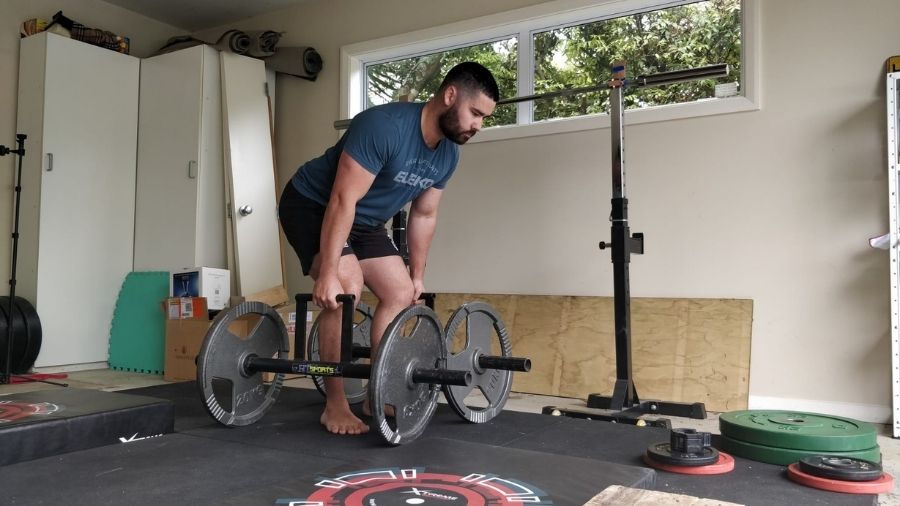The last thing you may associate boxing with is heavy deadlifting. I get it. As a boxer, you want to be smooth, rhythmic, loose, and be able to flow. But deadlifting for boxing may have benefits that can up your boxing performance.
Deadlifts can be a good exercise to develop lower body maximal strength and speed for boxing that targets the posterior chain muscles of the glutes and hamstrings.
Let’s answer the question likely at the forefront of your mind. Are deadlifts going to increase your punching power?
Do Deadlifts Increase Punching Power?

Punching power is highly influenced by the contributions from the legs. The most experienced and high-level boxers have greater contributions from the legs when punching compared to less experienced boxers [1].
When boxers are classified by style, knock-out artists also show greater contributions from the legs when punching compared to speedsters and players indicating the importance of powerful legs. This has been further confirmed within recent research where within elite amateur boxers, jump performance was highly related to how hard they punched [2].
Discover The Little Known Secrets For Unlocking Devastating KO Power!
Heavy hands are built doing these things...
Getting stronger and more powerful legs is a huge part of the answer to how to punch harder. Deadlifts can be part of that equation. I say can be because they don’t have to be. In my experience, squats for boxing are better leg strength builders.
You are able to take the legs through a full range of motion and place huge stress on the legs. The deadlift, while placing the body under even greater loads, taxes the back heavily compared to the leg musculature.
However, the deadlift preferentially targets the hip extensor muscles of the glutes and hamstrings which are powerful muscles of the legs. But there may be better variations of the deadlift that you can use to build strength in these muscles to carry over to punching power.
Trap Bar vs. Conventional Deadlifts For Boxing

If you’re choosing between conventional deadlifting and the trap bar deadlift, I would highly recommend choosing the trap bar deadlift for boxing. There are a couple of reasons:
- Trap bar deadlifts allow greater peak power and velocity when lifting the same load as the conventional deadlift and you can lift more weight with the trap bar [3].
- Trap bar deadlifts place less stress on the lower back and increases the stress on the quads compared to conventional deadlift [4].
- Trap bar deadlifts make it easier to reduce the range of motion, if necessary, with high handle placements.
All we care about is how much force, speed, or power we can produce during the deadlift. Not the exact muscle activation patterns. If we can produce greater force, speed, and power at each load, you will see greater improvements in these attributes in the long term.
Further, targeting the glutes and hamstrings is much easier with less stress on the body using hip hinge or deadlift variations. You’ll put greater stress on these muscles leading to greater strength gains or positive changes in muscle architecture because you are able to put the muscles through a larger range of motion.
Deadlifts For Boxing
You’re not only stuck with the conventional or trap bar deadlift. There are plenty of other deadlift variations you can use for boxing. Here are some examples.
Romanian Deadlift
This is the perfect exercise to pair with the squat. While squats heavily tax the glutes and quadriceps, the hamstrings don’t get much love. While we are not bodybuilders that need to focus on specific muscular hypertrophy, training muscles that often get neglected in boxing training and in boxing strength training is important for the overall reduction in injury and creating robustness.
The Romanian deadlift is not as taxing as a heavy deadlift but it will place greater stress on your hamstrings and glutes through hip extension.
Deadlift With Bands Or Chains
Using bands or chains when deadlifting is known as variable or accommodating resistance. The idea is that it changes the strength curve to allow greater velocities and acceleration of the bar. In turn, improving your ability to produce force quickly.
Current research suggests not to exceed 25-30% of band tension on the bar as it shows no further increase in bar velocity [5]. As in, if you are lifting 200 lbs, you should have no less than 140 lbs of bar weight. The rest is made up of band tension or chain weight.
Because you don’t need to decelerate to the same extent as when deadlifting without bands or chains, you can accelerate for longer through the entire movement.
Trap Bar Jumps
Remember when I mentioned that jump performance correlates very highly with punching force? Some boxers may not like the feeling of jumping with a bar on their back when performing jump squats.
The trap bar jump is a great alternative. You can perform them two ways. By picking the trap bar up and performing a countermovement jump where the plates don’t touch the ground. This would be very similar to the squat jump and utilizes the stretch-shortening cycle which is vital for power development.
The other variation is to jump when a dead stop with the bar resting on the floor. This removes any elastic energy involvement that would occur in the first variation mentioned. It is considered starting strength which is the ability to accelerate quickly from a dead stop position.
Punching often employs starting strength especially with the first punch in a combination. You don’t have time to wind up and recoil as it will be too slow and you are giving an obvious tell to your opponent.
Should You Deadlift Or Squat For Boxing?
There is no reason you can’t use both the squat and deadlift for boxing. But you will need to vary the volume and intensity of each so you are not taxing yourself too greatly. For example, you don’t want to squat and deadlift heavy within the same week when you are boxing often.
Instead, you may squat heavy for maximal strength development, and perform banded trap bar deadlifts or trap bar jumps to develop the speed and power side.
Are Deadlifts Good For Boxing?
Deadlifts can be a good exercise for boxing. But if you are going to deadlift as one of your main lower body exercises, opt for the trap bar variation as you get gain higher outputs. Finally, I would personally use the squat as the main lower body strength movement and deadlift variations for posterior chain development.
Are You Getting Stronger But Not Seeing It Transfer To Knockout Power?
Strength Train Like A Professional Boxer specifically designed to develop elite level knockout power without unwanted weight gain.


References
1. Filimonov VI, K.K., Husyanov ZM, & Nazarov SS., Means of increasing strength of the punch. NSCA Journal, 1985. 7: p. 65-66.
2. Luturco, I., Nakamura, F, Artioli, G, Kobal, R, Kitamura, K, Cal Abad, C, Cruz, I, Romano, F, Pereira, L, & Franchini, E., Strength and power qualities are highly associated with punching impact in elite amateur boxers. Journal of Strength and Conditioning Research, 2016. 30(1): p. 109-116.
3. Lockie, R. G., Moreno, M. R., Lazar, A., Risso, F. G., Liu, T. M., Stage, A. A., … & Callaghan, S. J. (2018). The 1 repetition maximum mechanics of a high-handle hexagonal bar deadlift compared with a conventional deadlift as measured by a linear position transducer. The Journal of Strength & Conditioning Research, 32(1), 150-161.
4. Swinton, P. A., Stewart, A., Agouris, I., Keogh, J. W., & Lloyd, R. (2011). A biomechanical analysis of straight and hexagonal barbell deadlifts using submaximal loads. The Journal of Strength & Conditioning Research, 25(7), 2000-2009.
5. Heelas, T., Theis, N., & Hughes, J. D. (2021). Muscle activation patterns during variable resistance deadlift training with and without elastic bands. Journal of strength and conditioning research, 35(11), 3006-3011.

